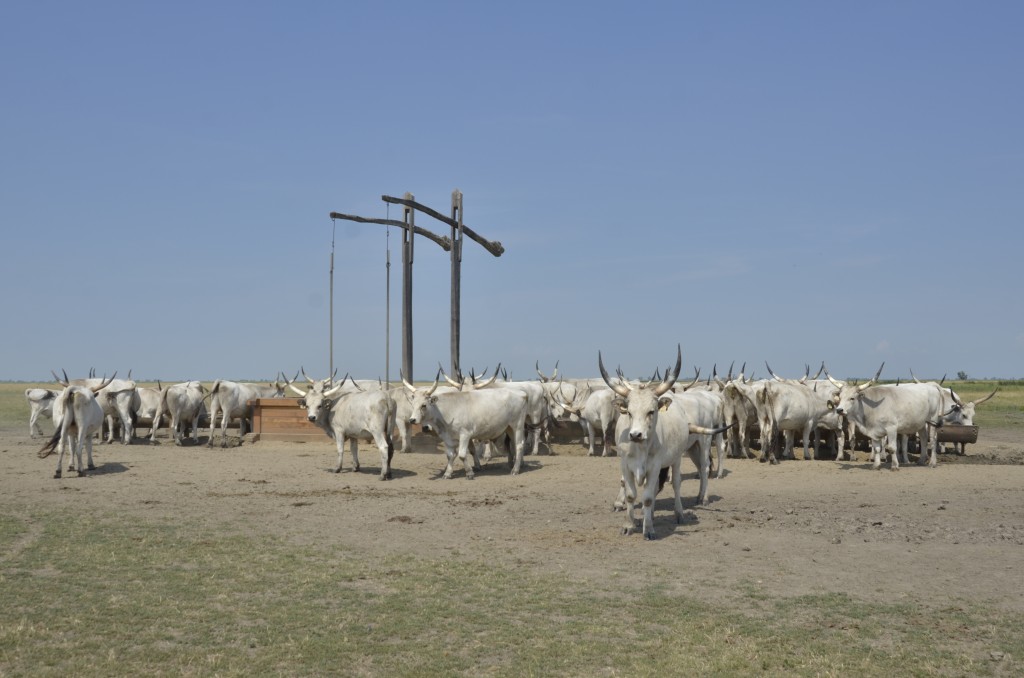Grazing animal husbandry on the puszta II.
The garments of the shepherds
The garment of the shepherds has preserved a lot of archaic traits until recently. One could even say that the shepherds' garment of the Hortobágy is the survival of the Hungarian peasant's costume until World War II.
The garment of the shepherd of the Hortobágy comprises the fehír- (white-dress) and the over-garment, where the cap and the footwear belong.
The white-dress is made of woman-woven linen: it is composed of the shirt and the gatya (long drawers). The shirt is not fitting and is not against the weather, it rather lines the overgarment. The pair of drawers is the oldest Hungarian article of clothing that is also comfortable and is used in the summer and in the winter too. This garment was worn in the country of origin and its linen was made of hemp. As the song says: "My drawers were made of 116 ells long linen?". Actually it has two very loose-fitting legs and that is why it is a comfortable garment of the horse-riding shepherd. The shepherd had two kinds of drawers: a light one for the summer and a thicker for the winter. Dipping it into tallow, which made it very leather-like, impregnated the latter. That was called tőgyfa-gatya (oaken-drawers). By the middle of the 19th century their fehír-garments and its fabric changed a lot because of the spreading of manufactured linen. It was replaced by the hip-length shirt made of blue-dyed linen, with blue glass buttoning up to the neck, and loose-fitting blue-linen hemmed drawers made of 4-5 selvages. The rangemen, the herdsmen, the swine-herds, the outlaws and the pandours all wore blue shirts, but not the shepherd - Ecsedi wrote in 1914.
When hiring shepherds, the owners made sure whether the applicant had a fine overgarment or not. The shepherd's overgarment was made of leather, according to the ancient practice. The sheepskin was the best for it. The shepherd made his garment himself. Shepherds wore their overgarment in bad weather. The most ancient and most primitive article is the hátibűr (~ back-leather ). It was made of the skin of a larger sheep and they only tanned it. It is put onto the shepherd's back by the two rear-legs and shirred by the waist with the tüssző (a wide belt with useful pockets). It is similar to the noblemen's kacagány, only it is not the skin of a tiger or panther. If doubled it is called mellybűr (~ chest-leather). The Cumans, the Pechenegs and the Uzes (another nomadic people) wear similar garments. In the 1860s the swine-herds of the Hortobágy wore mellybűr through the winter. The winter "great fur-coat" was made of the skins of several Racka sheep. In the time of King Matthias, noblemen wore this sleeve-less cloak-like fur-coat as well, only they lined its inside with soft drape and cloth. Any worth-while shepherd could make a fur-coat, although there were specialists of fur-coat tailoring.
One of the favourite garments of the Hungarian people is the szűr (~ felt-cloak) that has often been sung in folk songs. Its modest variant, the undecorated szürkankó is an ancient costume. The shepherds of the puszta have worn it until recently. Before it went out of fashion it had been the Sunday clothes of the village people. If we compare it with the costumes of the aristocracy, it can be paralleled with the coat, overcoat in its function. But the people of the village never put it on, they wore it pertly, slung over the shoulder. That is why its sleeve lost its original function and was sewn in to function as a pocket afterwards.
"The sleeve of my cloak is tied in,
Brown girl, do not rummage it over!
In one, there is steel, flint and tinder,
A hundred-forints note is in the other!"
The peasant-lads of the Hortobágy region did not marry until they got their own cifraszűr (~ embroidered felt-cloak). Its message-conveying role was important in wooing. Because the lad who arrived in his felt-cloak for the occasion, deliberately left it in the house when leaving. If his introduction did not please the parents, well, his felt-cloak was put out to the porch by the morning. That is the origin of the famous saying "kiteszik a szűrét" ("his cloak was put out." = He got the sack.). The embroidered felt cloak accompanied the peasant through his whole life. He married in it and when he died it was covered onto his coffin when put into the grave.
The little herds-boy received a felt-cloak as his first payment. Getting the felt-cloak has always been a great concern for the shepherd. The embroidered felt cloak always costed high and the money could not be got in a straight way. That is why the authorities forbade the wearing of the embroidered felt cloak before 1848.
The basic material of the cloak, the cloth, was made by the maker of freeze, its tailoring and cutting was made by szűr-makers who had their centre in the Csapó Street of Debrecen.
According to the embroidery, the cloaks of Debrecen and the Hajdúság are different from those of the Kunság, Bihar and farther regions (of Transylvania, the Bakony, Somogy, etc.). As Györffy writes: "the real embroidered felt cloak of Debrecen was born with three embroidery-spots and died with them too." It is true that on the cloak of Debrecen there was embroidery and appliqué on the shoulders; downward from the armholes, on the aszály; and on the back of the cloak, by the waist.
The head-gear of the Hortobágy shepherd was the wide-rimmed, semispheric, black, felt cap. The winter head-gear, the süveg, was made of the skin of a black sheep and was a "curly haired fur-cap with bulged-in top, the inside lined with the fur of a white sheep". The name of the rimmed felt cap was süveg in the Hortobágy, even in 1758. According to Ecsedi, our ancestors of the Conquest used both the rimmed and the rimless version of the hat. Allegedly it became fashionable all over Europe through the Hungarians. The famous wide-rimmed hat of the Hortobágy shepherds did not evolve into its present form until the 19th century. However, the hats of the shepherds are different. Compared to the wide-rimmed hats of the rangeman and the herdsman, rim of the shepherd's hat is smaller and he wears it more straightway. The decoration made of horse-hair or strap and the crane or bustard-feather stuck next to it all belong to the hat. The álladzó is made of strap and it holds the riding horseman's hat, even in a windy weather.
The footwear of the shepherds of Hortobágy is adjusting to the weather, to the ground and to the life-style of its owner. The riding rangeman and herdsman wear boots, while the shepherd and the swine-herd take lighter footwear, the bocskor (~ a sandal-like footwear) in the summer. Our ancestors also wore boots. The boots of the shepherds were made by the boot-makers of Debrecen, and were accompanied by a pair of spurs, formerly nailed on the boots, but later only strapped onto it. The bocskor was made of cowhide, or the legs of old boots, and the shepherd made it himself. In the 16th-17th centuries the bocskor-production in Debrecen was blooming. Its professionals were the bocskor-makers and the cobblers. In 1607, it could have been great demand of bocskors, because the municipal council ordered that, considering the requirements of the people, the bocskor-makers and cobblers had to be provided with enough material.
The people of the neighbouring villages had abandoned certain characteristics of the shepherd-image, while the shepherds still preserved them. Such were the pleached, tufty hair-style, and the besmearing of the hair with tallow against maggots. The formerly described impregnation of the drawers and the wearing of the felt-cloak and the wide-rimmed hat should also be considered as organic parts of extensive animal husbandry.
Shepherds' Art of the Hortobágy
Ottó Herman introduced the concept of shepherds' art in the ethnographic literature in 1892. In his study he differentiated between shepherds' arts of the Great Plain, the highlands, the Transdanubian and the Transylvanian variants. In 1940 Gábor Lükő investigated the psychic basis of this art, he characterized its style and motifs. He claimed that the shepherds' art of the Hortobágy is essentially similar to the Hungarian folk-art. Its merit is that it conserved the carving and engraving art of the Great Plain. A surplus of its merits is that it preserved the technical and formal treasures of the decorative art of the Magyars of the Conquest for more than a millennium, in such patterns like the tree of life, spinning-rose, chalice, etc. that were only partially conserved in other artistic creations. Its artistic merit is its individual nature.
The shepherds of Hortobágy decorated almost everything that passed through their hands. But not all of them had the talent to do it. Those with talents, the excellent artists had real fame all over the puszta. They had a lot of work though, since their companions also had their tools made or decorated by them for ordering. The decorated sticks, shepherd's hooks were not for everyday work, those became accessories of the Sunday best. Their formation was urged by the fact that, since the middle of the 19th century, these objects became the symbols of the shepherd-society. The symbolic tools of the rangeman, the herdsman, the shepherd and the swine-herd differed respectively.
The decorated objects of the shepherd were mostly made of leather. The most important basic material, the hasi, was carved out from the perished cattle's hide from the underbelly. The strap necessary to the whip and the varró were both made of it. The leather for the knife-sheath was taken from the thicker skin of the cattle's leg and bottom. Slicing up the shin of a calf or a sheep makes a decoration, the boglár, which shows nice on the caparison. The shepherd bought the coloured leather, from which the pillangó ("butterfly"), the decoration of the whip or the pouch, was made, at the skin-dealer in Debrecen. He used everything he found for decoration: copper-wire, scrapped soldier-buttons, and pieces of glass, pieces of broken combs or later India rubber.
The kíszsíg should be mentioned first among the products of the shepherds' art from the Hortobágy, being a decoration of the rangeman, the herdsman, the shepherd and the swine-herd as well. Ottó Herman wittingly wrote: "The whole készség, called erszény (pouch), is the same for the shepherd, as the "necessaire" for the gentleman; but since the shepherd wears his pouch hanging from his waist (namely on his leather-belt), it is his ornament as well, on which he expends all his appropriate sense of beauty." So, what was this erszín and kíszsíg? The equipment the shepherd always keeps handy is: his fire-makers, the steel, the flint, the tinder and his knife in separate sheaths, all on a ring. Before the invention of the match, travelling people kept such facilities with them. This was completed with the clay-pipe and the ornamented tobacco-pouch of the cut tobacco. The highly decorated bullwhip was mostly used by rangemen and herdsmen. "He did not cut the animal with it, only flipped to them." The whip is fastened to the short handle richly decorated by inlays, strap-plaitworks, slashes and pillangós by a ring. That is the origin of its name too (karikás ostor ~ ringed whip). The shepherd's bugyelláris (purse), sewing-case and masinatartó (~ "machine-keeper") are also made of the underbelly-hide.
The other available material is the horn. Drinking horns, salt-keepers and sheaths for keeping the mange-ointment in were made of it. The geometric figures and plants scratched with the knife-point remind us the decorations of plates from the Conquest.
The third material is the wood. Besides the formerly described stick, the carving art of the shepherds is manifested in the razor-, and the mirror-cases, and in the "books" (a book-shaped case) for the soap and the brush. Some of these are really beautiful, with leaden plates.
The horse-headed tambourines of the shepherds of the Hortobágy are considered to be the top of folk plastic-art. The other beloved instrument of the shepherd is the flute that he also made himself. The seven-holed, soft-sounding one is the furulya (record), while the loud one is the duda (pipe). The furulya made of willow and the duda have accompanied the shepherd everywhere. These instruments inspired the folk songs of the Hortobágy.
The artistic inclinations of the shepherds were not manifested only in carving and making of the karikás or the készség. Some of them were rhymers, but since they never wrote the poems down they were passed on orally. Most of them are obscene, like the one scorning the stingy master.
The belief system of the shepherds of the Hortobágy
The beliefs of these shepherds are basically identical with the beliefs of their home villages. If there is any difference, then it should be based on the fact that the shepherds are in a closer contact with nature and in this respect their concepts are more intense and rational. For example they know more about the weather, the winds, the constellation or about the plants of the puszta.
The baleful, malefic witch, that appears changing its shape and is especially active in hexing animals, has a central role in the belief-system. The figure of the tátos, táltos (a kind of shaman) is also well-known. A famous táltos was Pízásó ("Money-digger") Pista who lived even at the beginning of the 1940s. He was always digging by the highway to Tiszafüred, he was looking for his treasures. In the winter he rambled through the villages of the region. Some believed to have seen a red book with him, from which he had got his knowledge. He is told to have been a friendly man, but if somebody have upset him "he made such a storm, that even the roofs were blown away by the wind."
The belief in the "wise shepherds" who are adept in curing animals was also widespread. At the beginning of the 20th century, such famous healers were János Bocskai, the herdsman from Nánás, and Mihály Tóth from Tiszaigar. Mihály Tóth removed the worm from the animal by incantation: "I tell you Saint Ivány! In the Szefü, there are nine red-motley worms. Not nine, but eight, not eight, but seven, not seven, but??. not one, but none. Drop out from it, drop out!" The "rabies-doctor", such as István Orvas Nagy from Karcag, or Márton Tóth from Tiszaigar were, could prevent and cure rabies. There were "wise shepherds" who spoke the language of the animals. Sándor Fejes from Polgár could drive away the flock of those who had made him angry, but he could round the flock up as well if he wanted to. Pista Bajzát from Szentmargita had similar powers. In the 1930s, Pali Szurtos, who wore the leather-dress made by himself, could calm down the stray animal by whispering into its ear. He could call back the stray horse and cattle as well. The knowledge of János Szürkelovas ("Grey-horse") Szalontai from Csege came from the "csikólíp" (foal's lien). He had taken the lien from the mouth of the foal during the parturition, dried it and used it in secret. Those "wise-shepherds" were also kept in mind who could take away the rats from the pen. The figures of the "wise-coachman" or "witching-coachman" were also well-known. They could stop and start the jibbers; and they could drive the injured horse to its destination.
The beliefs survived longer in the relatively closed world of the shepherds than among the inhabitants of the neighbouring villages.
















